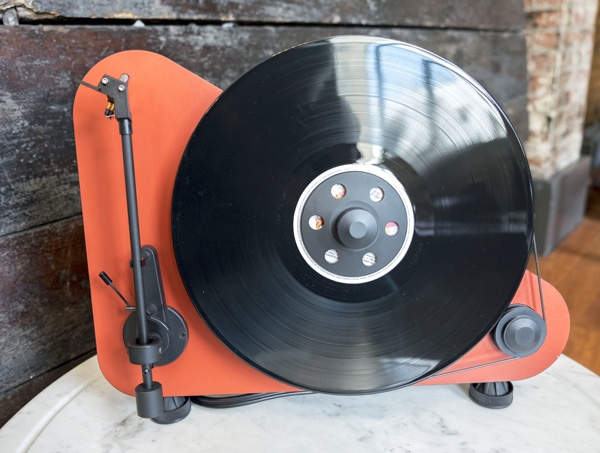| Columns Retired Columns & Blogs |
WoM presents Pro-Ject Audio Systems in New York City

Pro-Ject Audio System's founder and President Heinz Lichtenegger debuted three products in Manhattan this past April 28. Among the upbeat Austrian's new wares were the Vertical turntable (above), the Classic turntable, and the DAC Box DS2 Ultra. Presented at World of McIntosh's SoHo townhouse, visitors were given a tour of the 1890s-built former New York City power substation, now beautifully renovated and stuffed floor to ceiling with audio gear from Sonus Faber, McIntosh, and of course, Pro-Ject.
Pro-Ject's new DAC Box DS2 Ultra (MSRP $799, noted Pro-Ject USA Director Buzz Goddard), uses the AsahiKASEI AK4490 DAC chip converting at 32 bits/784kHz, and offers DSD256, multiple filter settings, three TosLink optical and two coaxial digital inputs, and is the first Pro-Ject product designed around a 4-layer PCB for shorter signal paths.
"We design many DACs," says the affable Lichtenegger, decked out in dapper brown blazer and canary yellow pants. "So for our 25th anniversary we wanted to make something really special, a DAC of high-end design with low cost. We are the only company using the AsahiKASEI AKM4490EQ chipset in a DAC that sells for less than $1000. We also do a 6dB gain stage, because there is no standard regarding input sensitivity for most manufacturers. But this DAC can adapt. Its asynchronous USB input is based on XMOS technology; it's very sophisticated.
"The Asahi chip allows five different filter settings," Lichtenegger continued, "'Natural,' 'Acoustic' and 'Traditional Tones,' and 'Acoustic and Traditional Sounds.' All the processing is performed at a very high sample rate (384kHz) making it very easy to use different filters. A lot of records today are [mastered] for iTunes and mobile phones. No one pays attention to the natural sound. The DAC Box DS2 Ultra's filter settings will give the best sound for your digital recording."
The Vertical or VTE turntable (MSRP $350) is a side-mounted design that includes a desktop stand and wall-mount option. Available in red, white and black, the VTE comes in both left- and right-handed versions. Brilliant! A straight, low-mass aluminum tonearm (also found on Pro-Ject's $199 Elemental turntable), MDF plinth and platter, outboard motor and factory-mounted Ortofon Super OM10 moving-magnet cartridge come standard with this belt-driven boomerang beauty.
"There's nothing special about a vertical table," Lichtenegger admits. "In the 1980s companies like Dual used a vertical turntable as a promotion to show how well they worked. Pro-Ject is an audiophile company; I come from the audiophile business. But I also come from retail and distribution and a small market, Austria—not a lot of rich people. My goal was give people high-end audio for the lowest cost. I meet a lot of people who appreciate good sound and who would like a turntable but they don't have the space. A vertical turntable can be mounted on very shallow shelving. Lifestyle magazines love the design of my vertical turntable; they put it in the middle of the room as a conversation piece. There is also an optional blue tooth model. Then you can use the turntable remotely from your hi-fi some meters away."
How does Pro-Ject apparently defeat gravity and enable the VTE to operate at a 90° angle?
"With a small spring near the back of arm," Lichtenegger replies. "It has a disadvantage with warped records; that changes the tracking force. So with a high-end table you don't use a spring. But this is not for high-end; this is for people who want a very nice hi-fi experience, but have a compromised environment. The anti-stake and tracking force is preset at the factory. The VTE is shipping soon and sounds better than any plastic table on the market."
The pièce de résistance of WOM's Pro-Ject event was the introduction of The Classic turntable. Resembling a vintage Thorens TD-166, Linn LP12, Heybrook TT2 or Lenco L78, The Classic is priced at an MSRP of $1199. The familiar looking LP-spinner features a carbon/aluminum tonearm, floating aluminum chassis fitted with Thermo Plastic Elastomer (TPE) damping material, an aluminum platter damped with more TPE, a brass bearing, and a newly developed zircon bearing system (and we're not talking Frank Zappa's tweezers).
"This is a completely new aluminum/carbon arm," Lichtenegger explains. "Carbon is super good for speed; aluminum damps the tonearm tube perfectly. So we have the stiffness of the carbon with the dampening of the aluminum. The counterweight has a TPE pad that damps the resonance frequency amplitude of the cartridge and the arm by 50%. If you get the resonance frequency wrong that creates boomy bass. We have also redesigned the signal wire; we put it through the main housing. It's tension free. We used a new material called zircon—a very rare, hard metal—which we put in the bearing. It's very fast and friction-free. The Classic has an MDF frame, and TPE balls instead of springs; this is a technology from Ortofon. We use the same TPE inside the platter. Each part of the turntable has a different amount of TPE depending on the frequency we need to kill."
Why does The Classic so closely resemble those nostalgic tables of yesteryear?
"I sold Thorens TD 166es and Linn LP12es and Heybrooks and Lencos in my youth—they all looked like this and I loved them," Lichtenegger confirms. "I wanted to make a turntable that looks like the older, classic tables but with modern materials so you don't have the disadvantages of the older turntables. The Classic gives the good looks of traditional turntable design with modern audiophile performance."
- Log in or register to post comments




































